| |
Photosynthesis,
the beginning of energy's flow through life; Food chains and energy pyramids; Energy changes and heat flow in Nature.
Science and technology education from FT Exploring |
|
 |
 |
 |
 |
 |
 |
|
|


|
 |
 |
|
|
|
| |
|
|
Photosythesis
is for the Birds - and Everything Else
|
|
| |
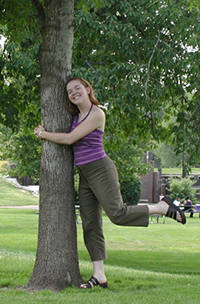
| |
This
girl once took trees for granted. Then she read our pages on photosynthesis. Now
she can't stop hugging trees. |
|
| |
|
|
 |
 |
 |
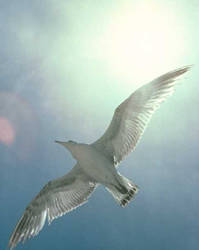 |
| |
This
seagull (like all the rest of us) is powered by solar energy. It's food is a form
of stored solar energy.
For a seagull, the energy could come originally from
phytoplankton (see energy pyramids) that was
eaten by a fish that died and was eaten by a crab that was then eaten by the seagull.
Or the energy could have come originally from grass that
was eaten by a cow that was made into a hamburger that didn't quite get eaten
and ended up on a garbage barge which, to a seagull, is just a great big smorgasborg.
The wind the bird soars on is driven by the sun's energy.
|
|
 |
 |
 |
|
|
|
| |
I
see your eyes glazing over. Big words that defy pronunciation. Complicated diagrams.
It's biology class!
Not here. These pages are photosynthesis made interesting!
You should know about this. When you understand the basics, you'll want to know
more. Photosynthesis is important to you. It keeps you, everybody, and everything
else alive. You'll never look at plants or slime the same. You won't want to interrupt
the grass by stepping on it. Don't bother the diatoms. They're busy. Photosynthesis
in progress! |
|
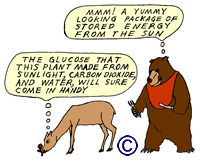 Glucose
is a type of sugar. Click here to learn
what it is and where it comes from.
Glucose
is a type of sugar. Click here to learn
what it is and where it comes from. |
 |
 |
 |
|
|
 |
 |
 |
|
|
| |
|
| |

Handmade
FT Exploring
colored pencil drawing. |
Here's
what happens:
Energy flows into the
earth in the form of electromagnetic radiation that most of us call sunshine.
The sun's energy heats the earth, makes weather, keeps us warm - thanks a lot.
But if that was all, this would still be a pretty dead
planet, and there would be no me and no you.
Plants and animals need energy to live, to grow,
and to make more of themselves.
All that solar energy pouring onto the earth everyday
wouldn't do us any good if we didn't have some way to turn it into a form of energy
that we can use. |
 |
 |
Well,
some under appreciated autotrophic life forms have "stepped-up"
to save the day. They've developed a way to take sunshine, and a few common molecules
from air and water, and turn them into something that the rest of us "non-autotrophs"
can use.
Everyday, without fanfare
or thanks, or anyone hardly noticing, these humble life forms make thousands of
tons of glucose (and other carbohydrates) and put thousands of tons of oxygen
into the atmosphere. Without all that oxygen and carbohydrates we animals would
be in big trouble.
|
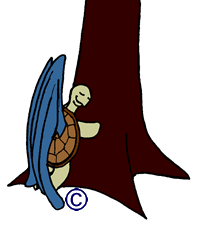
"Thanks for
the Oxygen" |
 |
 |
Photosynthesis
is the beginning of the amazing journey of energy and the basic materials of life
from plant to animal to animal to decomposer (see the stuff on Food
Chains).
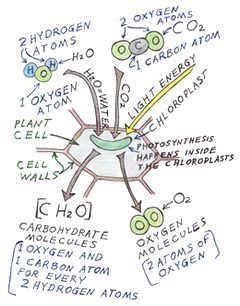
For the molecules and atoms that living things are
made of, the journey is a cycle that repeats itself over and over. You might be
made of a few carbon or oxygen atoms that were once part of a dinosaur or a wooly
mammoth.
For energy, the trip is sort of a one time thing
- in and out. All the energy that moves through life eventually ends up as heat
and radiates back into space - from whence it came. If it wasn't
for that nice big dose of new energy coming in from the sun every day, we would
all soon be very cold and in a permanent frozen state of "not-living".
Take the tour. Explore the wonders of photosynthesis,
energy, and life.
The links listed in the green box
in the left hand column above will take you to pages that will explore this
fascinating process and the further adventures of energy. Take
the tour and follow the links. Every thing is interconnected in FT
Exploring.
You can't take a wrong link. But if exploring makes you nervous, use the
Navigation Page to help you find your
way.
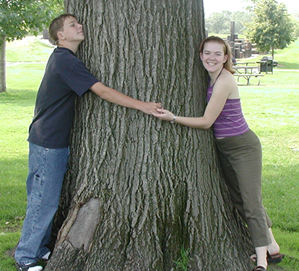 |
| "Thanks
for the Glucose!" |
 |
|
|
|
 |
 |
 |
|
|
| |
|
|
 |
 |
 |
 |
 |
|
|


|
|
©Copyright
2014, 2022. David E. Watson. All rights reserved. Everything
in the Flying Turtle web site is copyrighted, either by us or
by someone else. For information concerning use of this material,
click on the word Copyright.
|
Autotroph
vs. Heterotroph
I know, I know, the teacher's not happy unless we learn new words. Here are two
pretty important ones to start us off on our journey into photosynthesis, food
chains, and energy.
Autotroph - Some living organisms can make
their own food from inorganic material (stuff that does not come from living things)
and sunlight. Green plants, algae, and certain kinds of bacteria, can all make
food for themselves from sunlight, carbon dioxide, and water (bacteria can use
some other things to make food too, but we won't go there). Autotrophs don't need
to "eat" anything or anybody. All they have to do is sit around, or
float around, catching some "rays", taking carbon from carbon dioxide
in the air (if they are land plants), and absorbing a little water. Living organisms
that can make their own food this way are called autotrophs,
or licensed practitioners of autotrophy (just
kidding, they don't need a license). Or, if you want an adjective (often more
impressive and learned sounding), they can be called autotrophic
organisms. The process they use to make food from these basic ingredients
is called photosynthesis. It is an extremely complicated and fascinating process,
but the basics are pretty simple and everybody needs to know the basics. So, in
the pages to follow, we are giving you an introduction free of charge to the basics.
Heterotroph - The rest of us are heterotrophs.
They could have called us "non-autotrophs", but we wanted our own name.
Heterotrophs can't make their own food from sunlight, carbon, and water. Heterotrophs
have to eat something. They have to eat an autotroph or another heterotroph. Then
they digest what they ate and turn it into food. Animals are heterotrophs. Animals
that eat only plants (most plants are autotrophic) are generally called vegetari...oops,
I mean Herbivores. Animals that eat mostly other animals are called carnivores.
Humans and other animals that eat both plants and animals are called omnivores,
or just plain "lucky". All three of them, herbivores, carnivores, and
omnivores, are unlicensed practitioners of heterotrophy.
It's not a crime.
So...the next time a grumpy person tells you not to stand on the autrophic organisms
in his yard, you'll know he means to stay off the grass. Won't you? |
|
|
|
|
|
|
|
©Copyright
2014, 2022. David E. Watson. All rights reserved. Everything
in the FT Exploring web site is copyrighted, either by us or
by someone else. For information concerning use of this material,
click on the word Copyright.
|
|
|
 |
 |
 |





